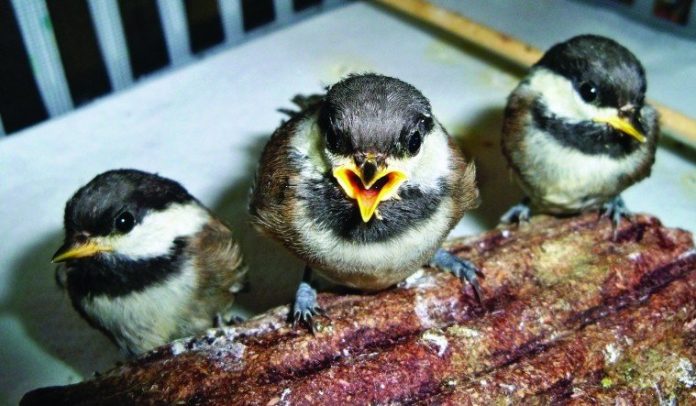“Four little chickadees singing in a tree, One flew away and then there were three. Chickadee, chickadee, happy today. Chickadee, chickadee, fly away.” – Lyrics by Peter and Ellen Allard
It very nearly wasn’t a happy trio of little chickadees. Early in May, a former volunteer for the Wildlife Education and Rehabilitation Center (WERC), now a teacher at a local school, happened upon a group of students oohing over a box containing some tiny baby birds. One of the girls said that the momma bird had been killed by a cat and so the girl decided to raise the babies herself.
Unfortunately, besides being illegal to keep a native wild bird, these nestlings were not being fed a proper diet according to their age and species. Maybe if the student had contacted WERC for advice first, she would have been told that the babies might not have been orphaned, but would continue to be fed by their father, a much better situation all around.
By the time they were brought to WERC, one of them had become very weakened and would have soon died. Volunteers immediately placed the nestlings in warm, clean nests and began feeding them a specially-prepared passerine diet every 15 minutes, sunup through sundown. It’s a job for only the most dedicated mom or dad, whether a natural parent or a human substitute.
The little threesome have thrived on this TLC. They have just been transferred to a small aviary for pre-release flight time and are offered a delicious choice of millet, seeds, suet, and most importantly, mealworms and flying insects. Chestnut-backed chickadees are voracious foragers of bugs, including caterpillars, aphids and ants. You can often see the birds hanging upside-down on tree branches or hopping on old logs, gleaning beetles, larvae or spiders from crevices. Wild chickadees also enjoy the sweetness (and bug-attractiveness) of backyard hummingbird feeders.
The native habitats of chestnut-backed chickadees are the dense, mixed coniferous forests of the Pacific Coast, from southern Alaska to southwestern California. Because the 4.5 inch long birds have readily adapted to suburban locales, they can also be commonly found in the backyards and parks of cities and towns, often seen in small groups at feeders with flocks of other small birds.
The handsome birds have distinctive coloring, with a perky black cap, white cheeks, a black bib and rump feathers that are a rich rufous-brown, “rufous” meaning light red as called out in its species name, Poecile rufescens. They are fascinating to watch and enjoyable to listen to. Their common name comes from their vocalization: A husky, high-pitched chik-zee-zee or a sharp chek-chek.
In addition to putting out the usual feeders with suet and black-oil sunflower seeds, if you would like to attract nesting chickadees to your backyard trees, one unusual enticement is to place brushings from your dog or cat around your yard. Chickadees build their nests in natural tree cavities (including abandoned woodpecker holes) and man-made bird houses, using moss, grass, feathers and the fur and hair of deer, rabbits, coyotes and other animals. These soft materials are also used to blanket their eggs when they leave the nest to look for food.
Chickadees, chickadees, fly away! The three fortunate siblings are almost grown and will be released mid-July at a prime chickadee habitat in the suburban woodlands of Morgan Hill, abundant with lots of bugs, conifer seeds and bird feeders to keep them happy for a long, long time.















